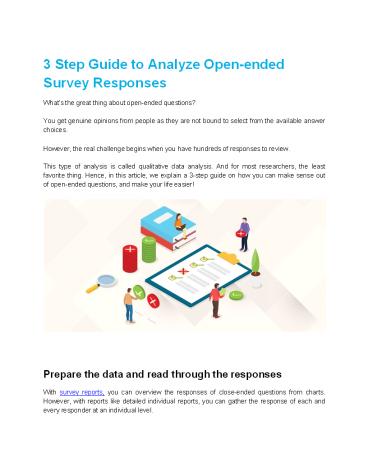3 Step Guide to Analyze Open-ended Survey Responses - PowerPoint PPT Presentation
Title:
3 Step Guide to Analyze Open-ended Survey Responses
Description:
Here’s your 3-step blueprint on how to analyze open-ended questions from your survey to get the best results. – PowerPoint PPT presentation
Number of Views:18
Title: 3 Step Guide to Analyze Open-ended Survey Responses
1
3 Step Guide to Analyze Open-ended Survey
Responses
Whats the great thing about open-ended
questions? You get genuine opinions from people
as they are not bound to select from the
available answer choices. However, the real
challenge begins when you have hundreds of
responses to review. This type of analysis is
called qualitative data analysis. And for most
researchers, the least favorite thing. Hence, in
this article, we explain a 3-step guide on how
you can make sense out of open-ended questions,
and make your life easier!
Prepare the data and read through the responses
With survey reports, you can overview the
responses of close-ended questions from charts.
However, with reports like detailed individual
reports, you can gather the response of each and
every responder at an individual level.
2
- After you have them, start reading. While trying
to understand them, make sure to label or
categorize them in a way that resonates with you. - For example, if the feedback is about not
receiving responses of tickers, you can use the
code poor customer service to categorize that
response and other responses that communicate a
similar idea. - A quick tip You can use an Excel spreadsheetadd
the responses in column A and assign each
response code in column B. You can sort column B
alphabetically to view which codes appear most. - You can also divide the responses into categories
like - Positive
- Neutral
- Negative
- Subcategorize and recheck
- Subcategorize them only if you find extra details
that could help. For example, if you find that
not getting a reply to the ticket is something
you have received a lot, add it in the negative
-- No ticket response. However, you can skip
this step because it depends on the replies that
you received. - Once you are done, make sure to go back and
re-read responses to make sure they fit properly
in the categories that youve assigned them. You
can also assign multiple categories to one
response since open-ended responses tend to cover
more than one thing usually.
Its time for results!
3
- Now that you have everything ready, it is time to
convert them into quantitative data/percentages.
For example, from your survey 30 of people had
positive things to say, 20 were neutral, and
50 had negative comments. - Quick tips
- Tally the number of times each code appears to
determine key issues. - In your final report, use verbatims to prepare
your findings. For example- - Finding
- The customer support system is not responsive
- Verbatim
- - "We never get the reply of our tickers"
- Do not forget your objective
- When analyzing the qualitative data, it is
important to keep in mind what your objective is.
Were you looking to find out if your customer
support is up to the mark? Just like that, write
down your objective and work around finding its
answer. It will help you gather effective
answers.
4
Source https//www.appjetty.com/blog/3-step-guid
e-analyze-open-ended-survey-responses































